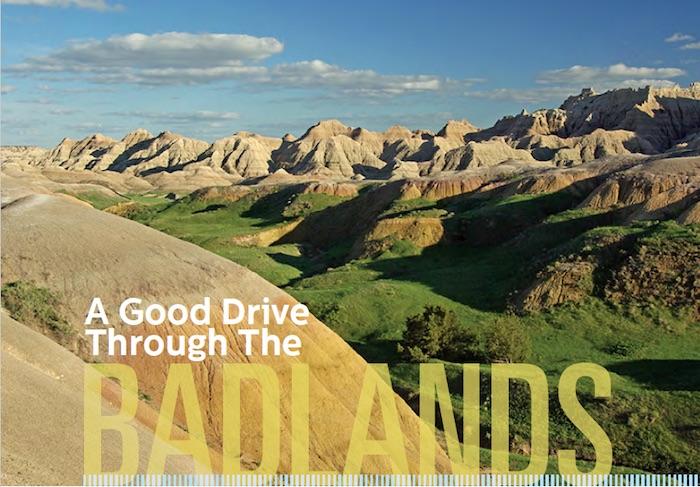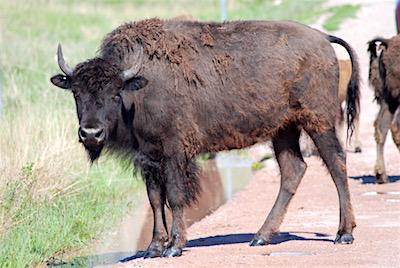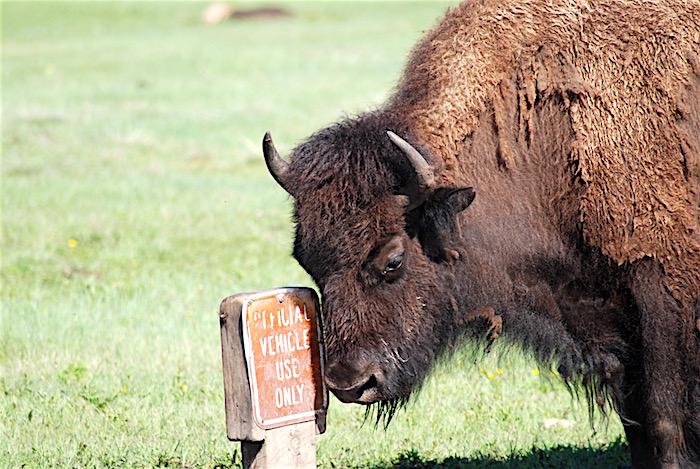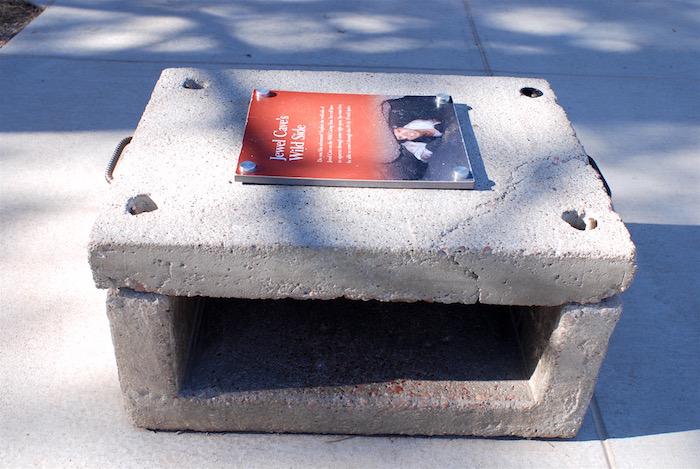
They had me surrounded at the border. The border of Wind Cave National Park and Custer State Park, that is. And “they” were a dusty herd of bison, moving from one lush meadow of grass to another, with their skittish young in tow.
That geyser-rich national park in northwestern Wyoming might be known as the bison capital of the National Park System, but here in southwestern South Dakota the bison at Wind Cave were out in full force and milling all about. Some paused briefly to consider whether I was a threatening predator or mere curiosity.
It took me nine hours to drive from my Utah home to Wind Cave, and smarter folks likely would opt to fly into Rapid City. However you get to South Dakota, there are some very good reasons to drive through this particular section of “flyover country.”
Rent a rig when you get off the plane in Rapid City. You’ll soon find yourself in wayward parts of the park system replete with bison, caves, and badlands that you will remember forever, particularly if you’re from a wet and lush landscape.
Jewel Cave National Monument, Badlands National Park, Wind Cave National Park, and Mount Rushmore National Memorial are all within an hour's drive from Rapid City. They alone will easily justify your spending a week’s vacation exploring these parks. Toss in the Crazy Horse Memorial and Custer State Park and 10 days or more wouldn’t be too short for an exploration of this landscape, both above and below ground level.

Young bison seem more leery and inquisitive than their elders. This one kept a close eye on the photographer / Kurt Repanshek
Where to begin? Head southeast from the airport 61 miles to Badlands National Park. Covering nearly a quarter-million acres, this park started out as a national monument in 1929. It is hauntingly beautiful in its seeming austerity, evidence of the harsh environment and the poor soils found here.
Badlands embraces a landscape that began to take form 69 million years ago, back when water covered the land. Once the inland sea drained away, the ebb and flow of rivers and floods added more sediment, and over the eons the rippled and eroded landscape was revealed as you see it today (top photo above).
Here and there in Badlands there are bits and pieces of ancient life. Back in 2010 a 7-year-old visitor to the park spied a partially exposed fossil that proved to be the skull of a 32-million-year-old saber-toothed cat.
You can start your exploration on the main park road that follows the northeastern boundary of the park’s North Unit. Stop at one of the overlooks and you’ll gaze out over a panorama of prairie and colorful badlands. Here you’ll find the park’s only lodging, Cedar Pass Lodge. Another resting place lies just outside the North Unit, near Wall Drug. Frontier Cabins Motel offers well-kept cabins, and even teepees for those seeking more Western flavor.
For more of an adventure, head to the park’s Stronghold Unit, which is part of the Pine Ridge Indian Reservation, and set out on foot to explore this rugged landscape. Just be sure to carry enough water, as what you’ll find there more than likely will not be fit to drink.
From Badlands, head southwest to Hot Springs, South Dakota, the gateway to Wind Cave. It’s approximately 60 miles of backroads, so check with locals about road conditions before setting out on this route. If you’re not adventurous, a 92-mile route that takes you through the Pine Ridge Indian Reservation might be safer.
Wind Cave is one of the oldest units of the National Park System, designated in 1903, when it became the country’s eighth national park. It was named for a small crevice in a hillside through which winds have been clocked at over 70 mph. Aboveground, the rolling, pine-studded surface of the Black Hills is beautiful, with several hundred bison, countless pronghorn antelope, and roving bands of elk.
Wind Cave’s bison herd started in 1913, when 14 of the animals—seven bulls and seven cows—were shipped from the Bronx Zoo via rail to the park to kick-start a bison conservation effort that is responsible for an astonishing number of today’s herds.

Bison park themselves wherever they want/Kurt Repanshek
Sign up for one of the park’s underground tours, where you’ll see rare and fragile boxwork formations. Aboveground there are some nice hiking trails at Wind Cave, or you can drive around the entire 35,000-acre park via U.S. 385, South Dakota 87, and park route 5 in about an hour. Take longer if you dally to stretch your legs in the rolling Black Hills setting.
Just about 45 minutes east of Wind Cave, tucked away in the Black Hills National Forest, is Jewel Cave National Monument. This overlooked park system unit was established in 1908 as a monument overseen by the U.S. Forest Service, which transferred it to the Park Service in 1933. While Wind Cave might have the world’s greatest collection of boxwork formations, Jewel Cave counters with the world’s greatest collection of calcite spar formations. It also happens to be the third-longest cave in the world, with nearly 200 miles of mapped passages and more exploration ongoing.
When the Park Service decided to expand the cave tours at Jewel Cave it had the help of cave explorers to choose where they should put the cave entrance. While the Natural Entrance is reached via a short hike, and is used these days for lantern tours, the main visitor center sits more than 200 feet above the so-called Target Room that Herb and Jan Conn discovered in the early 1960s.

To go on the wild cave tour at Jewel Cave National Monument, you have to squeeze through this block/Kurt Repanshek
Midway through that decade, after some meticulous aboveground mathematical calculations determined the exact spot above the Target Room, an elevator shaft was sunk down to this chamber. Today you get a quick, 27-second ride down to the Target Room to begin the popular Scenic Tour.
Don’t neglect the monument’s aboveground trails. Unless you’re waiting in line to buy your cave tour ticket when the visitor center opens at 8 a.m., you might have to wait an hour or more for your trip. Spend it taking a hike down the Canyons Trail.
From Jewel Cave, head east on U.S. 16 to the town of Custer, S.D., and just beyond it Custer State Park. Sharing a common border with Wind Cave, this state part boasts about 1,300 bison in its herd, roughly four times as many as the national park next door. You could spend a week at Custer fishing, hiking, paddling a canoe, and watching wildlife.
Afterwards, follow U.S. 16A to Mount Rushmore National Memorial to see the iconic stone presidents—Washington, Jefferson, Lincoln and Roosevelt—that were carved into the Black Hills during a 14-year period (1927-1941). From there, it’s only about 24 miles back to Rapid City and your flight home.
Helpful Tips:
* The summer months, June, July and August, are the busiest at Mount Rushmore.
* There is no camping at Jewel Cave National Monument. Wind Cave National Park has one of the nicest campgrounds in the park system, with 63 sites.
* With proper planning, you could do a morning cave tour at Wind Cave, and an afternoon tour at Jewel Cave. Or vice versa.
* A campsite or cabin at Custer makes a great basecamp for day trips to Wind Cave, Jewel Cave and Mount Rushmore.
* The Sturgis Motorcycle Rally in nearby Sturgis, S.D., in early August can be noisy and brings crowds to the area.
Coming Sunday: A closer look at the subterranean world of Wind Cave National Park and Jewel Cave National Monument



Comments
Sounds like a good vacation idea! Thanks!
I've driven midst a buffalo herd both in Yellowstone and in northern British Columbia and it is a significant occurrence, to realize that most of the animals could totally destroy your own car.
It's quite remarkable that they don't act like this (fictional situation) more often:
https://www.youtube.com/watch?v=__brXlweyh4
But here's one where a bison decides to use this family's rental car to scratch itself.
https://www.youtube.com/watch?v=qwSjRJFUcoc
Thanks for mentioning Jewel Cave--it's an underappreciated site that's well worth a visit. I took the "tourist" cave tour there many years ago, which was fun even for a claustrophobe like me. I remember looking at that same concrete block in the visitor center and thinking, "no way am I gonna do that tour." Just seeing your photo of it gives me the sweats.
For a fun armchair caving experience, read Herb and Jan Conn's The Jewel Cave Adventure: Fifty Miles of Discovery. Even if you're not a caver, it'll have you on the edge of your seat. Just don't read it in a low-ceilinged room!
I've had the privilege of knowing Jan (and her husband Herb, now gone) from living in the same town (Custer, SD) for 20 years. Amazing couple, in addition to their cave explorations they put in many of the climbing routes in the Needles here decades ago. Their book is a must-read for sure.
Thank you so much for this informative article! I'm new at traveling and you've just planned out my whole trip. I'm looking forward to seeing everything you listed. I appreciate the time and effort you put into this journalism.